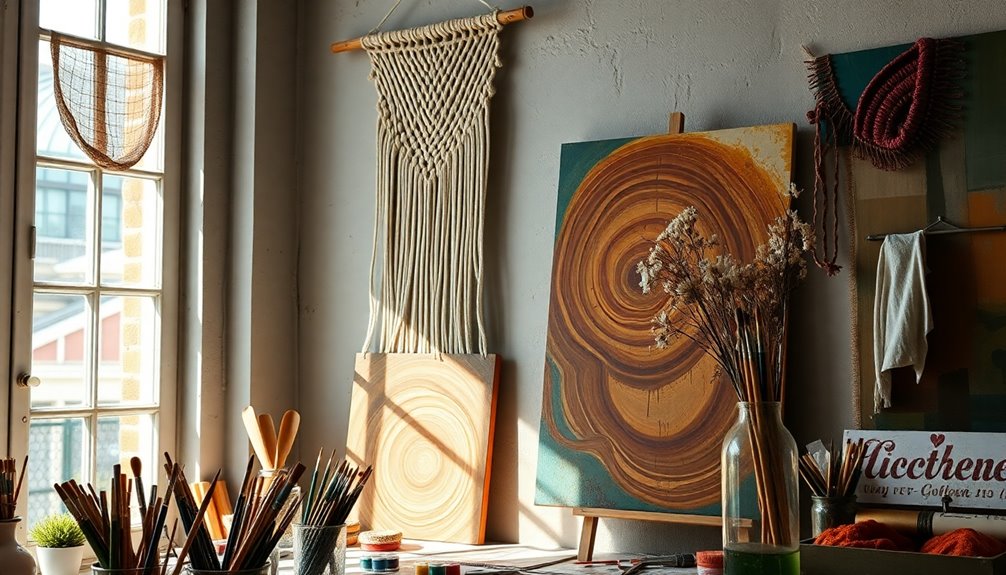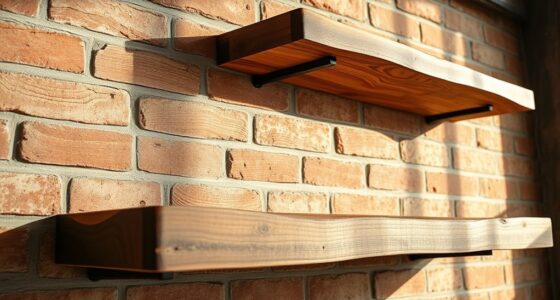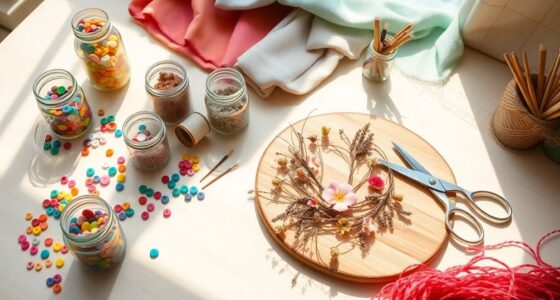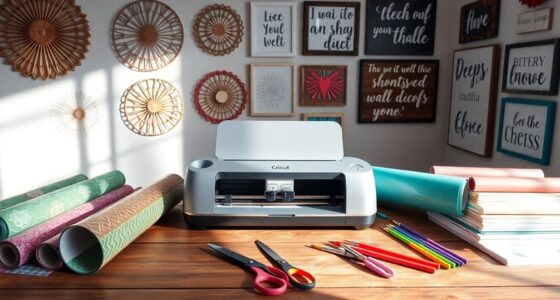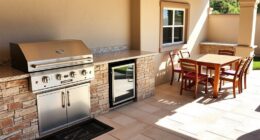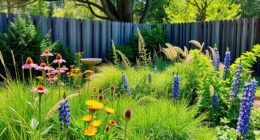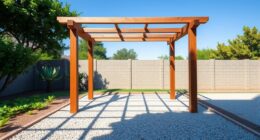Creating boho art is all about expressing your free-spirited style through color and texture. Start by gathering materials like canvas, watercolor papers, and vibrant paints. Look for inspiration in nature, personal experiences, or eclectic travel moments. Experiment with color palettes that include earthy tones or bold hues. Embrace mixed media techniques by layering different materials or using tactile elements. Incorporate personal symbols or memories for a unique touch. Finally, trust your instincts and let your creativity flow. If you keep exploring, you'll discover even more ways to enhance your artistic journey and style.
Key Takeaways
- Embrace vibrant colors and earthy tones, mixing warm and cool shades to capture the bohemian spirit.
- Incorporate natural elements and textures, such as fabric, wood, and organic materials, to enhance visual interest.
- Experiment with mixed media techniques, layering various materials like paper, paint, and embellishments for depth and character.
- Draw inspiration from nature, travel, and personal experiences to create unique narratives that reflect your free-spirited style.
- Allow for imperfections and spontaneous creativity, celebrating the art-making process and your personal expression.
Essential Materials and Supplies
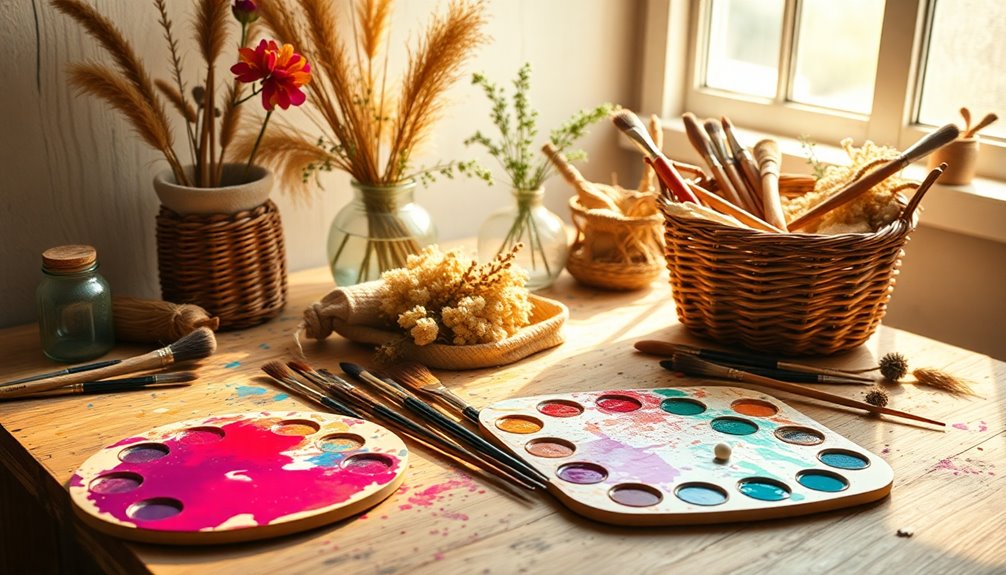
To create stunning boho art, you'll need a variety of essential materials and supplies.
Start with your canvas options—choose from stretched, rolled, or canvas boards. For a rustic feel, consider wooden panels.
Don't forget textured papers, like watercolor and mixed media. You'll also want paints; acrylics, watercolors, and oils provide vibrant colors.
Add inks, markers, and glues for mixed media effects. Tools like brushes, craft knives, and rulers help with precision.
Embellishments such as ribbons, buttons, and natural elements elevate your work.
Finally, gather frames and easels for display and comfortable working.
Organizing your materials in containers and ensuring good lighting will enhance your creative process, making it easier to express your unique style.
Finding Inspiration Sources
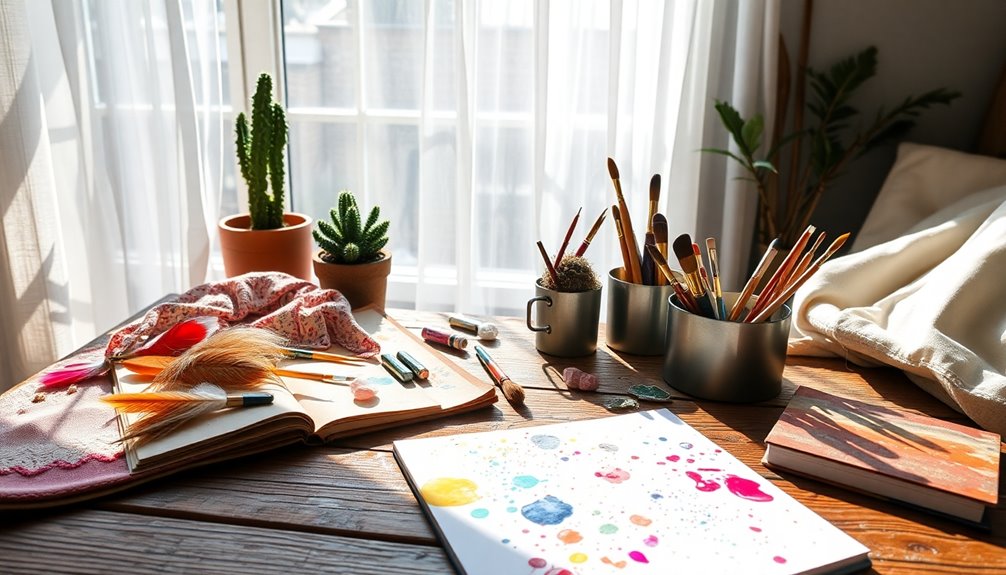
Once you've gathered your materials, the next step is to explore where to find inspiration for your boho art. Nature's beauty can spark your creativity—think about landscapes, flora, and fauna that resonate with you.
Seasonal changes and geological features can also add depth to your work. Don't forget to draw from travel experiences; local markets, street art, and cultural traditions offer vibrant colors and patterns.
Your personal experiences are rich sources too—memories, emotions, and dreams can shape your artistic expression.
Finally, investigate art history; studying movements like bohemian art and surrealism can provide fresh perspectives. By blending these elements, you'll cultivate a unique style that truly reflects your free-spirited essence.
Exploring Artistic Techniques
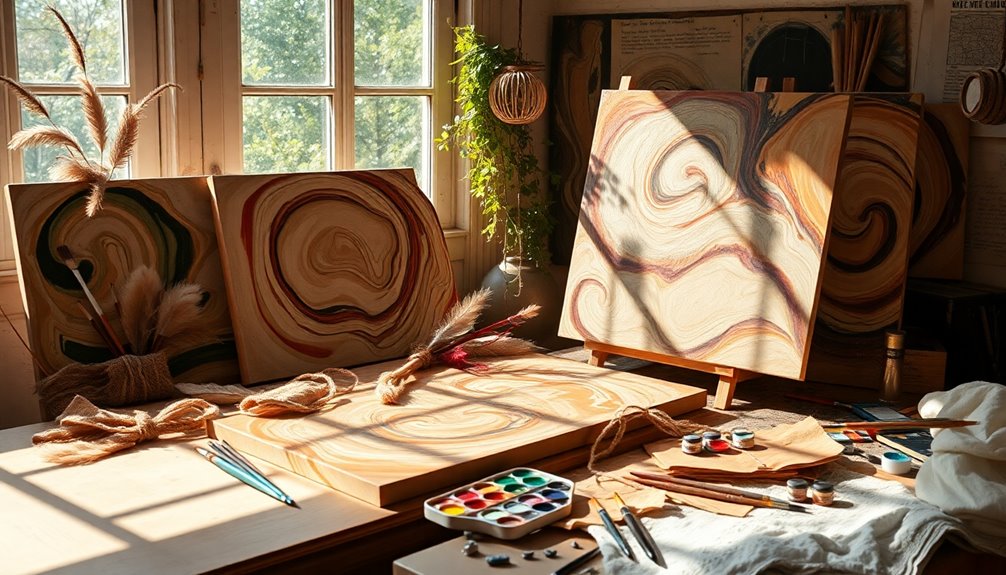
As you immerse yourself in creating boho art, exploring various artistic techniques can greatly enhance your creative expression.
Start by understanding color theory; using complementary colors creates contrast, while analogous colors provide smooth shifts. Incorporating essential oils for mental clarity may also help stimulate your creativity.
Master brushstrokes like drybrushing for texture or wet-on-wet for seamless blending. Consider incorporating premium quality easels to support your painting process, as they can enhance your overall experience.
Experiment with different mediums; oil paints offer rich depth, while acrylics and watercolors allow for versatile applications.
Pay attention to composition by balancing symmetry and asymmetry, using negative space to guide the viewer's eye.
Create focal points with size or color to draw attention.
Layer your elements to add depth, making your artwork feel alive.
Embrace these techniques as you develop your unique boho style!
Choosing a Color Palette

Choosing the right color palette is essential for creating an enchanting boho art piece, especially since the colors you select can evoke specific emotions and set the overall mood.
Start with earthy tones like warm sandy beiges and ivories as your foundation. These neutral colors create a calming base, while soft teals, peaches, and dusty roses can add visual interest. Incorporating earthy rust tones can also enhance the warmth and comfort of your palette. Additionally, using natural elements in your artwork can help mimic the organic feel of boho style.
Don't shy away from incorporating vibrant hues; mixing warm and cool tones can create a dynamic atmosphere. For a cozy feel, layer muted warm tones like rust and auburn.
Remember to balance your palette with natural elements, like greenery or textured finishes, to enhance the organic, free-spirited essence of your boho art.
Creating a Mood Board
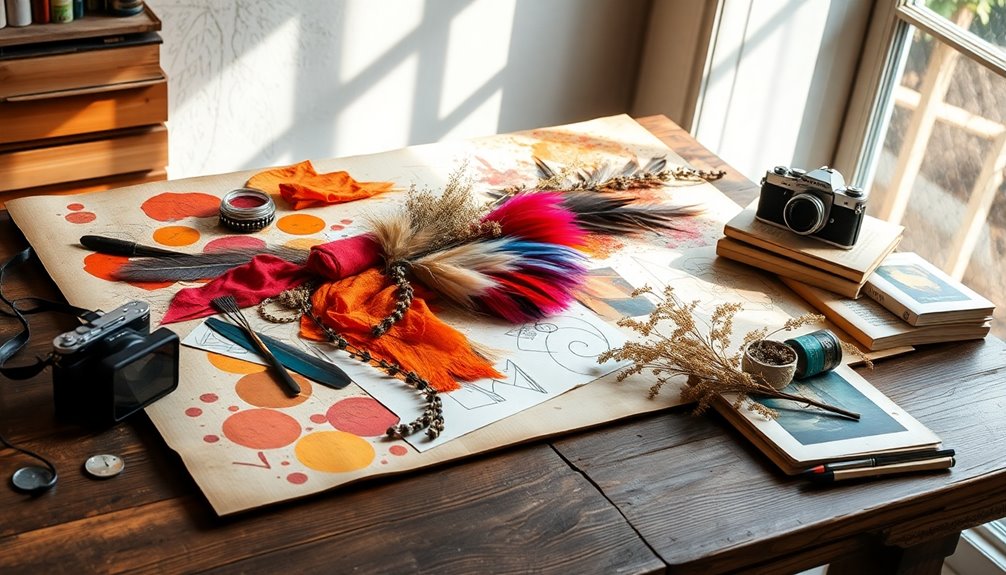
Creating a mood board can be an exciting way to visualize your boho art concept, helping you gather inspiration and refine your ideas.
Start by defining your theme and purpose, which will guide your selections. Collect visuals, textures, and colors from sources like Pinterest or nature. Don't forget to include inspirational quotes and small objects that resonate with your vision.
Once you have your materials, plan a balanced layout, grouping similar items for cohesion while allowing negative space to prevent clutter.
Regularly review and adjust your board to stay aligned with your aesthetic. You can use digital tools for easy editing or display a physical board for quick reference. Additionally, consider incorporating natural materials to enhance the organic feel of your design.
Document the process to inspire future projects!
Tips for Displaying Art
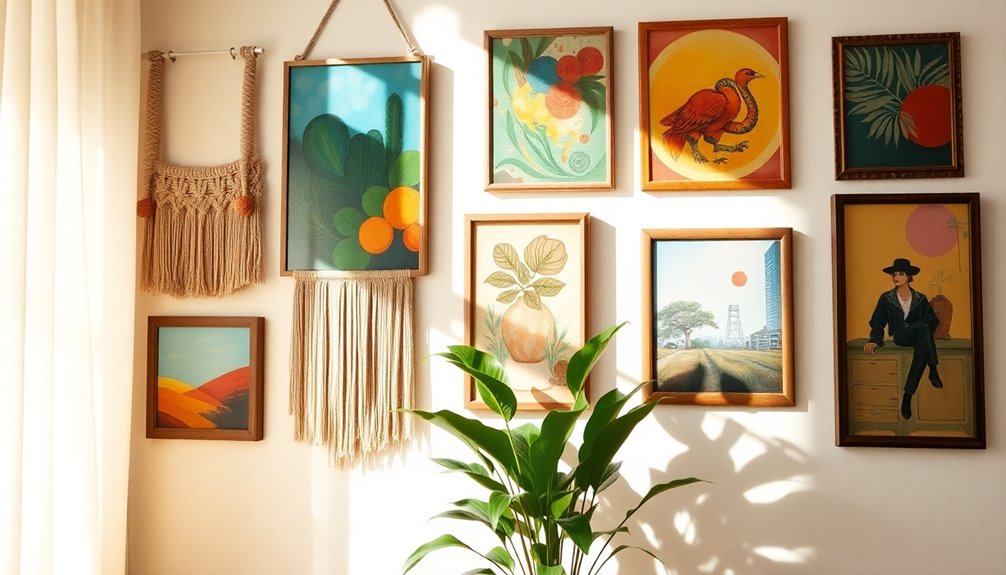
Displaying your boho art effectively can transform your space and enhance its charm. Start by choosing the right frames; opt for natural materials like wood or rattan, and mix sizes and shapes for visual interest. Vintage frames add a unique touch.
Next, select the perfect wall—textured surfaces and natural light make art pop, while coordinating colors guarantee harmony. Grouping pieces creates a focal point, so vary their heights for added appeal.
Utilize shelves and ledges to create a dynamic display; stack frames and decorative items but leave space to avoid clutter.
Finally, experiment with hanging methods like macramé or twine to add a rustic feel and adjust heights for variety. Embrace your creativity! Incorporating unique handcrafted decor items can further enhance the individuality of your art display. Consider incorporating seasonal elements, such as festive lights or themed accents, to create a dynamic look that evolves throughout the year. Additionally, explore options for displaying your art alongside seasonal pieces—this is especially fun when integrating costco halloween decoration ideas that can add a playful twist to your decor. By rotating these items, you not only keep your space fresh but also create a personalized gallery that reflects your unique style and interests.
Styling Your Art Space
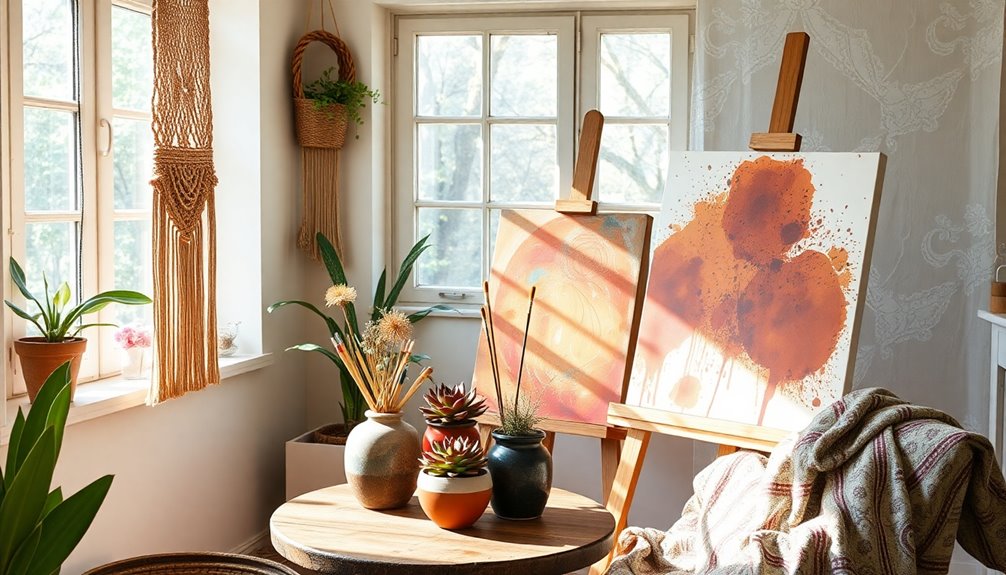
While styling your art space, it's essential to reflect on how each element harmonizes with your boho art. Start by choosing a color scheme; neutral backgrounds like beige or gray create a clean canvas, while earthy tones add warmth.
Don't shy away from bold accents in vibrant shades to spark visual interest. Next, select a mix of art pieces, including vintage finds and abstract art, to capture that free-spirited essence.
Incorporate textiles like macrame wall hangings and eclectic throw pillows for texture. Finally, add natural elements such as potted plants and driftwood to connect with nature. Additionally, consider using rustic wooden furniture to enhance the overall aesthetic of your art space.
Together, these choices will create a cohesive and inviting bohemian atmosphere that showcases your unique artistic style.
Incorporating Personal Experiences

Your art space isn't just about aesthetics; it's a canvas for personal expression. Reflect on your emotions and let them guide your artwork. Create mood boards that capture different feelings, and weave personal stories into your pieces. Use symbolism and a color palette that resonates with your experiences.
Incorporate memories from significant life events, drawing from journal entries or photographs as inspiration. Include places and people that matter to you, adding layers of meaning.
Utilize personal objects like collectibles, heirlooms, or nature elements to enrich your art. Explore autobiographical themes, arranging your work chronologically to tell a story.
This approach creates depth and complexity, making your art a true reflection of your journey.
Experimenting With Mixed Media
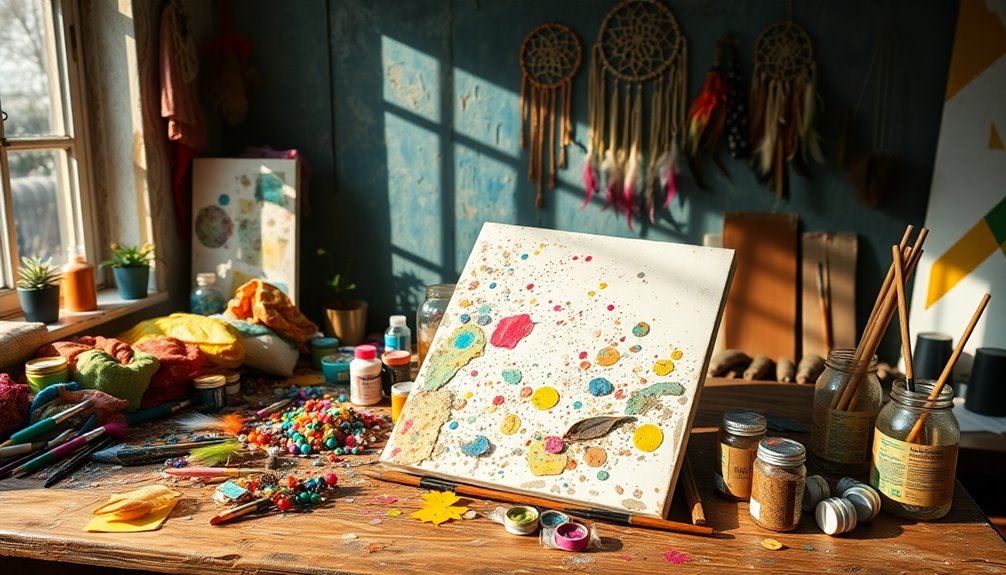
Experimenting with mixed media opens up a world of creative possibilities that can transform your artwork into a rich tapestry of textures and stories.
Start by layering tissue paper and light fabrics with acrylic paints, sealing each layer with clear acrylic medium. Allow each layer to dry for depth and complexity. Chia seeds are also high in fiber, which can inspire you to create art that promotes wellness and healthy living.
For a collage, combine different papers, photographs, or digital prints, cutting and tearing elements to create a cohesive visual narrative. Use adhesives to secure your pieces and develop focal points.
To add tactile dimension, incorporate materials like molding paste and sand. Manipulate these textures with brushes or sponges, enhancing them further with Paint Couture Glaze for added drama and interest.
Exploring layering techniques can also lead to unexpected and delightful surprises in your artwork.
Let your imagination run wild!
Embracing Your Unique Style
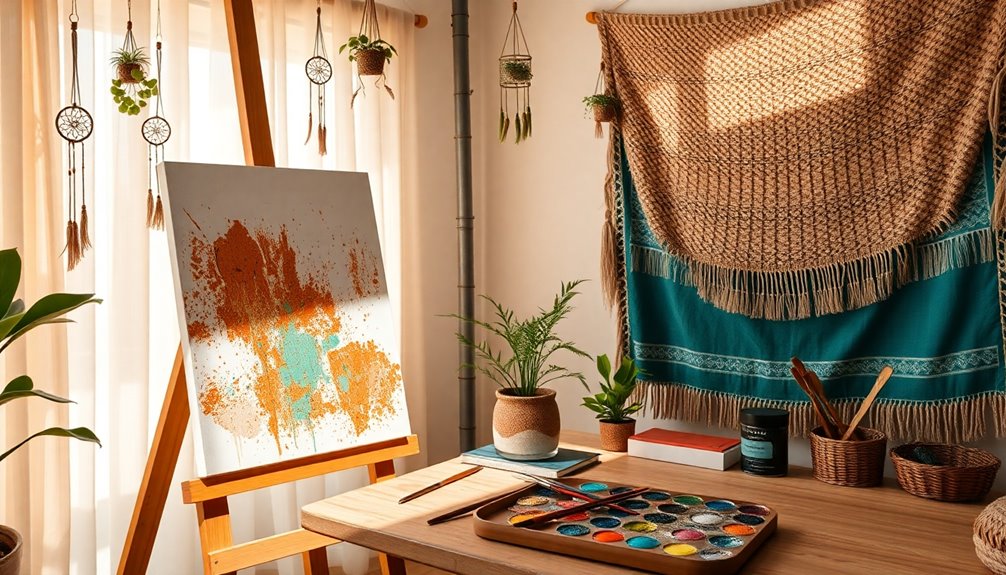
After exploring the endless possibilities of mixed media, it's time to focus on what truly makes your art one-of-a-kind.
Start by defining your aesthetic—identify influences from various cultures and art movements, and reflect on your favorite colors and themes. Look to artistic icons like Frida Kahlo for inspiration.
Next, experiment with different mediums, from watercolor to digital art, and incorporate handmade elements that resonate with you.
Don't forget to infuse personal symbols and nature elements into your work. Embrace imperfection by leaving raw edges and experimenting with texture.
Remember, your art should reflect your journey, so allow it to evolve naturally as you express your unique style.
Trust your instincts, and let your creativity flow!
Frequently Asked Questions
How Do I Choose the Right Size for My Art Pieces?
To choose the right size for your art pieces, start by measuring the wall space where you'll hang them.
Consider the room's layout and existing furniture, ensuring the art complements the overall decor.
Think about the piece's purpose—larger works can make a statement, while smaller pieces may fit better in cozy corners.
Finally, remember to create balance with negative space, allowing your art to shine without overwhelming the room.
Can I Use Digital Tools for Creating Boho Art?
You might think digital tools can't capture the essence of boho art, but that's not true!
You can absolutely use software like Procreate or Adobe Photoshop to create stunning pieces that reflect your free-spirited style. These programs offer a variety of brushes and features to help you explore textures and colors.
Plus, platforms like Canva make it easy to design collages, bringing your artistic vision to life with a modern twist.
What Are Some Common Mistakes to Avoid in Boho Art?
When creating boho art, avoid common mistakes that can hinder your vision.
Don't overemphasize trends or rely too heavily on commercial elements; authenticity is key. Make sure to incorporate personal touches and balance different styles.
Pay attention to color coordination, lighting, and textures to enhance depth. Keep a cohesive theme, utilize negative space effectively, and remember to celebrate handmade elements.
These tips will elevate your boho art and showcase your unique style.
How Do I Maintain and Preserve My Boho Art?
To maintain and preserve your boho art, start by dusting it regularly with a soft cloth and avoiding harsh chemicals.
Keep it out of direct sunlight to prevent fading. When handling, use clean hands and store it in acid-free cases.
Use UV-filtering glass for framing and monitor humidity levels.
Rotate your artwork occasionally and keep it away from pets to avoid accidental damage.
Document your pieces for future reference and insurance.
Where Can I Find Boho Art Workshops or Classes?
You can find boho art workshops or classes in various places.
Check online platforms like Udemy and Skillshare for courses that suit your interests. Local art studios, community centers, and galleries often host classes too.
Don't forget about social media—Instagram and Facebook groups can connect you with artists offering workshops.
Finally, keep an eye on local events and festivals, where you might discover hands-on opportunities to learn and create bohemian art.
Conclusion
Creating boho art is all about embracing your unique style and letting your creativity flow. You might worry that you don't have the right skills or experience, but remember, art is subjective and personal. It's not about perfection; it's about expression. So, don't hesitate to experiment with your materials and techniques. Immerse yourself in your artistic journey with an open heart, and you'll find joy in every piece you create. Let your free spirit shine!
